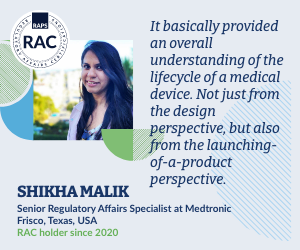Industry groups call for changes in ICH M11 guideline on harmonized protocols
![]() Regulatory News | 22 February 2023 |
Regulatory News | 22 February 2023 |
In comments to the US Food and Drug Administration (FDA), pharmaceutical industry groups called for revisions to the International Council for Harmonisation’s (ICH) M11 guidance establishing a harmonized template for clinical trial protocols. The groups said the document should be revised to broaden the definition of a protocol, recommended that the use of estimands be justified in the protocol and include more examples of real-world data (RWD).
The guidance also includes a template for the format called the “Clinical Electronic Structured Harmonized Protocol (CeSHarP), as well as a set of specifications.
The draft guideline was released for comment in October 2022. FDA received 14 comments on the draft guidance. (RELATED: ICH releases M11 guideline proposing harmonized template for trial protocols, Regulatory Focus 25 October 2022).
Expand purpose of the protocol
Both the Pharmaceutical Research and Manufacturers of America (PhRMA) and the Biotechnology Innovation Organization (BIO) suggested that the definition of a protocol be expanded to state that protocols should also cover the purpose of the trial and its design.
The draft states that “the clinical protocol describes the processes and procedures directing the conduct and analysis of a clinical trial of medicinal product(s) in humans.”
BIO wrote that “the clinical trial protocol does not only describe processes and procedures for the trial conduct and analysis but also provides details on the trial purpose and design.” PhRMA concurred, stating that the definition of the protocol be expanded.
BIO and PhRMA want alignment on terminology
Both BIO and PhRMA also recommended that the term “clinical trial” is too restrictive and should be replaced with the term “clinical study.”
PhRMA states that the use of the term “study” would ensure alignment with the terminology used in the ICH E8(R1) Guideline on General Considerations for Clinical Studies and also provide clarity on the scope of the Template. “Study” is a broader term and should be used to reflect the diverse types of studies that are in scope for the protocol template.”
BIO writes that “we request changing to the use of 'study' instead of 'trial' to align with ICH E8(R1), and to ensure clarity on the broad scope of this template. We question the choice of the term 'trial' instead of 'study' to denote interventional studies. 'Study' is clearly the broader term and is needed to reflect the many types of studies that are in scope for this template if it is to cover 'all phases of clinical research and all therapeutic areas' as stated in section 0.2. The use of 'trial' is far more restrictive in its meaning.”
Industry wants sponsors to justify the use of estimands
BIO also suggested that the guideline be revised to state that sponsors should justify their use of estimands in their protocols and that the guideline should be better aligned with the ICH E9 R1 guideline on estimands.
TransCelerate BioPharma, a nonprofit industry partnership focused on biopharmaceutical research and development, also called for the guideline “to clarify why the estimand justifies the study objectives.” The group also recommended including a rationale for estimand selection.
The draft guideline specifies that sponsors should describe the attributes that construct the estimand: the treatment condition of interest, the population of participants targeted by the clinical question of interest, other intercurrent events and a population level summary.
ICH defines estimands as a “precise description of the treatment effect reflecting the clinical questions posed by a given trial objective [and] summarises at a population level what the outcomes would be in the same patients under different treatment conditions being compared.” Without a precise description of the trial objective and the treatment effect, there is the risk that the study will be designed inappropriately.
RWD and Phase 1 studies
PhRMA also suggested that the template be revised to incorporate more examples of real-world data.
“As real-world data (RWD) is becoming more common to support protocol data collection procedures/activities, PhRMA recommends revising the template to explicitly accommodate for the use of RWD sources …The content to be included should be flexible to accommodate as much detail as needed to ensure transparency and clarification of such data sources and their processing activities (e.g., standardization mappings, transformations, etc.).”
BIO suggested that the guideline include additional text to address Phase 1 studies. “This template is mostly focused on the concept of confirmatory trials including estimands. Pilot studies are only mentioned in Section 9.8, Sample Size Determination. Please consider adding a paragraph in the beginning of the document to talk about the requirements for Phase 1 studies.”
Comments
The guidance also includes a template for the format called the “Clinical Electronic Structured Harmonized Protocol (CeSHarP), as well as a set of specifications.
The draft guideline was released for comment in October 2022. FDA received 14 comments on the draft guidance. (RELATED: ICH releases M11 guideline proposing harmonized template for trial protocols, Regulatory Focus 25 October 2022).
Expand purpose of the protocol
Both the Pharmaceutical Research and Manufacturers of America (PhRMA) and the Biotechnology Innovation Organization (BIO) suggested that the definition of a protocol be expanded to state that protocols should also cover the purpose of the trial and its design.
The draft states that “the clinical protocol describes the processes and procedures directing the conduct and analysis of a clinical trial of medicinal product(s) in humans.”
BIO wrote that “the clinical trial protocol does not only describe processes and procedures for the trial conduct and analysis but also provides details on the trial purpose and design.” PhRMA concurred, stating that the definition of the protocol be expanded.
BIO and PhRMA want alignment on terminology
Both BIO and PhRMA also recommended that the term “clinical trial” is too restrictive and should be replaced with the term “clinical study.”
PhRMA states that the use of the term “study” would ensure alignment with the terminology used in the ICH E8(R1) Guideline on General Considerations for Clinical Studies and also provide clarity on the scope of the Template. “Study” is a broader term and should be used to reflect the diverse types of studies that are in scope for the protocol template.”
BIO writes that “we request changing to the use of 'study' instead of 'trial' to align with ICH E8(R1), and to ensure clarity on the broad scope of this template. We question the choice of the term 'trial' instead of 'study' to denote interventional studies. 'Study' is clearly the broader term and is needed to reflect the many types of studies that are in scope for this template if it is to cover 'all phases of clinical research and all therapeutic areas' as stated in section 0.2. The use of 'trial' is far more restrictive in its meaning.”
Industry wants sponsors to justify the use of estimands
BIO also suggested that the guideline be revised to state that sponsors should justify their use of estimands in their protocols and that the guideline should be better aligned with the ICH E9 R1 guideline on estimands.
TransCelerate BioPharma, a nonprofit industry partnership focused on biopharmaceutical research and development, also called for the guideline “to clarify why the estimand justifies the study objectives.” The group also recommended including a rationale for estimand selection.
The draft guideline specifies that sponsors should describe the attributes that construct the estimand: the treatment condition of interest, the population of participants targeted by the clinical question of interest, other intercurrent events and a population level summary.
ICH defines estimands as a “precise description of the treatment effect reflecting the clinical questions posed by a given trial objective [and] summarises at a population level what the outcomes would be in the same patients under different treatment conditions being compared.” Without a precise description of the trial objective and the treatment effect, there is the risk that the study will be designed inappropriately.
RWD and Phase 1 studies
PhRMA also suggested that the template be revised to incorporate more examples of real-world data.
“As real-world data (RWD) is becoming more common to support protocol data collection procedures/activities, PhRMA recommends revising the template to explicitly accommodate for the use of RWD sources …The content to be included should be flexible to accommodate as much detail as needed to ensure transparency and clarification of such data sources and their processing activities (e.g., standardization mappings, transformations, etc.).”
BIO suggested that the guideline include additional text to address Phase 1 studies. “This template is mostly focused on the concept of confirmatory trials including estimands. Pilot studies are only mentioned in Section 9.8, Sample Size Determination. Please consider adding a paragraph in the beginning of the document to talk about the requirements for Phase 1 studies.”
Comments
© 2025 Regulatory Affairs Professionals Society.









![Good Clinical Practice (GCP) [2.0 RAC]](https://my.raps.org:443/images/9ccf9834-70e1-45d7-bff4-c95e88b94d08.img?resize=yes)




